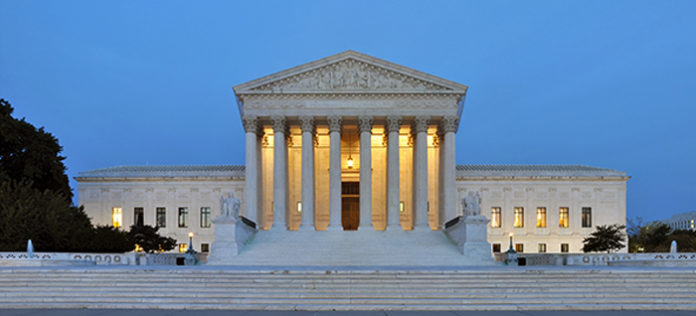
Judge Amy Coney Barrett has openly discussed her reverence for the judicial philosophies of Justice Antonin Scalia, whom she clerked for. And since President Donald Trump nominated her to the U.S. Supreme Court on Sept. 26, her legal career has been picked apart for signs of how she might approach cases over abortion rights, the Affordable Care Act and the Second Amendment. In those discussions, a 2019 dissent she wrote as a member of the 7th Circuit Court of Appeals has resurfaced.
The appeals court had a case in which a man convicted of mail fraud for selling shoe inserts to podiatrists, which were not approved for Medicare and Medicaid reimbursement, challenged the permanent federal and state ban in Wisconsin on felons owning firearms. The 7th Circuit upheld the district court’s rejection of his challenge. In Barrett’s dissent, she argued founding-era legislatures barred only people convicted of violent felonies from having firearms, and believes a broad ban on convicted felons possessing them is inconsistent with history.
Although the dissent is the single example of a Second Amendment case Barrett had a part in deciding, experts in constitutional law say it clearly lays out her originalist jurisprudence on both the Second Amendment and constitutional law broadly.
Chris Jackson, a partner at Holland & Hart, said he believes Barrett’s decision in Kanter is a clear indication of how she views the Second Amendment. Because there isn’t a lot of Supreme Court case law on the Second Amendment, the area has a lot of room for circuit court judges to rule in ways consistent with their individual judicial interpretation of laws about firearms, he said.
“There’s just a lot of open space in the law about how the Second Amendment operates and what kind of scrutiny different laws get. There are a lot of open questions, and so a circuit judge’s decision on this issue right now is almost certainly going to track what they actually believe, because there isn’t a Supreme Court case telling them they have to go the other way.”
The U.S. Supreme Court’s 2008 decision in District of Columbia v. Heller established for the first time that the Second Amendment protects individual rights to have firearms outside a militia context. But Jackson said the court went out of its way to clarify that right doesn’t bar presumptively lawful, historically established restrictions, such as prohibiting certain groups of people from having firearms and allowing schools and government buildings to ban them.
He added the federal and state governments’ ability to bar felons from having firearms has been among those restrictions seen as long-established, a nuance on which Barrett centered her dissent in Kanter.
David Kopel, research director of the Independence Institute think tank and an adjunct professor of constitutional law at the University of Denver, said Barrett’s dissent in Kanter is a window into her originalist view of constitutional law and also highlights the challenge for lower courts in applying the scope of the Heller case. He said permissible restrictions in firearms possession the Supreme Court discussed in the Heller decision as presumptively permissible don’t seem to be as firmly established in history as the court assumed.
“Really, subsequent scholarship has shown that’s really not so true. And most of the things they talked about as presumptively constitutional … those laws are not as long-standing as I think the court imagined they were,” Kopel said. “So that’s one of the challenges and difficulties for lower courts in figuring out what they’re supposed to do with Heller.”
Mark Gibson, a senior associate at Hogan Lovells who submitted an amicus brief to the Colorado Supreme Court on behalf of the Brady Campaign to Prevent Gun Violence in Rocky Mountain Gun Owners v. Polis, said a 6-3 conservative Supreme Court majority with Barrett’s appointment could give the court the vote count of four justices it needs to grant cert on more Second Amendment cases, where they have been historically reluctant to hear them. As an example, Justice Clarence Thomas has written dissents in cert denials saying the Supreme Court’s refusal to hear Second Amendment cases essentially consigns them to inferior status among constitutional rights.
Gibson said lower courts have tended to apply the intermediate scrutiny test in analyzing firearms laws, a standard requiring that a law intended to further a key government interest use means substantially related to that interest. But thae Supreme Court has not said whether the right to have firearms is a fundamental right, so there is uncertainty about which standard is required in looking at laws restricting them.
“One thing that’s really remarkable about the Second Amendment is how little the Supreme Court has told us about it,” he said. “The question that is getting litigated in the lower courts is, what level of regulation can states and local governments impose on the right?”
—Julia Cardi

